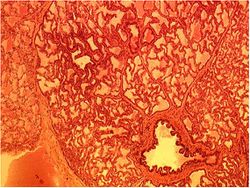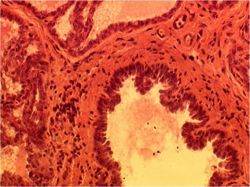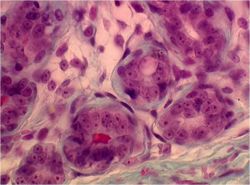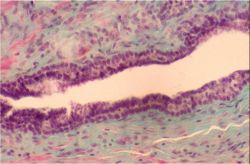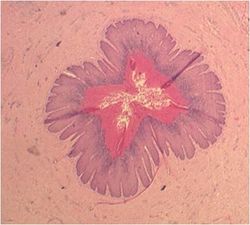Difference between revisions of "Mammary Gland - Anatomy & Physiology"
Jump to navigation
Jump to search
Fiorecastro (talk | contribs) |
|||
| (119 intermediate revisions by 10 users not shown) | |||
| Line 1: | Line 1: | ||
| − | + | '''''Development of the Mammary Gland (prenatal mammogenesis)''''' | |
| − | |||
| − | + | * An ectodermal thickening developes along the ventral body wall extending from the thoracic to inguinal region - this is the '''mammary ridge'''. | |
| + | * Cells aggregate, multiply and differentiate to form a chain of condensed '''mammary buds'''. | ||
| + | * Most mammary buds regress, those that remain and develop each give rise to a '''mammary gland'''. A mammary gland is the secretory and duct system associated with one teat. | ||
| + | * Mammary buds grow into overlying mesenchyme and '''primary epidermal sprouts''' grow out of the bud apex. The epidermal sprout branches extensively and develops a complete '''duct system'''. | ||
| + | * Mammary adipose tissue is derived from mesoderm. This is required for complete mammary development and is thus absent in the male. As a result, mammary development in the male is halted at the epidermal sprout stage. | ||
| − | |||
| − | + | '''''Position and Morphology''''' | |
| − | + | *Cow: 2 pairs of teats, Inguinal, 1 canal per teat | |
| + | *Ewe: 1 pair of teats, Inguinal, 1 canal per teat | ||
| + | *Goat: 1 pair of teats, Inguinal, 1 canal per teat | ||
| + | *Mare: 1 pair of teats, Inguinal, 2/3 ducts per teat | ||
| + | *Sow: 8 pairs of teats, Thoracic-Inguinal, 2/3 ducts per teat | ||
| + | *Bitch: 4 pairs of teats, Thoracic - Inguinal, 5/6 ducts per teat | ||
| + | *Queen: 4 pairs of teats, Thoracic - Inguinal, 5/6 ducts per teat | ||
| − | |||
| − | + | '''''Anatomy''''' | |
| − | + | ''Arterial Supply and Venous Drainage'' | |
| − | + | * In species with '''inguinal mammary glands''' (cow,ewe,goat,mare), the main blood supply is from the '''external pudendal artery'''. This arises indirectly from the external iliac artery via the femoral artery. The external pudendal artery passes through the inguinal canal. | |
| + | Due to the extensive blood supply in the cow, there is also a small contribution from the internal pudendal artery which is a branch of the internal iliac atery. Also, the external pudendal artery has a sigmoid flexure to permit the artery to stretch when the udder is full of milk. | ||
| + | * In species which also have '''thoracic mammary glands''' (bitch,queen,sow) blood supply is from the '''internal thoracic artery''' and its branches - cranial and cranial superficial epigastric arteries. | ||
| − | + | * Venous drainage is through '''sattelite veins''', except in ruminants. | |
| + | * During lactation in ruminants, the external inguinal vein cannot drain the extensive amount of blood present. Thus, the '''cranial and caudal superficial epigastric veins''' anastamose to form the '''milk vein'''. Also, right and left mammary veins anasamose to form a ring around the base of the udder. Valves become non-functional to accommodate the increased venous return and allow blood to flow in either direction. This is important, for example if a cow were to lie down, the weight on one side would collapse the thin-walled veins on that side so anastamoses ensure continued venous return. | ||
| − | |||
| − | |||
| − | + | ''Lymphatics'' | |
| + | * Inguinal mammary glands: superficial inguinal lymph node | ||
| + | * Thoracic mammary glands: axillary lymph node | ||
| − | |||
| − | |||
| − | + | ''Innervation'' | |
| + | * Sympathetic: Innervation to the blood vessels and teat sphincter smooth muscle via the '''genitofemoral nerve'''. | ||
| + | * Somatic: Ventral rami of spinal nerves. In the cow, spinal nerves L1-L4 and the pudendal nerve innervate the udder. | ||
| + | Mammary glands are mainly under the influence of endocrine hormones. | ||
| − | |||
| − | |||
| − | + | ''Suspensory apparatus'' | |
| − | + | Organised into lateral and medial laminae which anchor the udder to the body wall by their attachment to the pubic symphysis. | |
| + | * Lateral Lamina: collagen fibres from the fascia of the pubic symphysis and the edge of the superficial inguinal ring. | ||
| + | * Medial Lamina: elastic fibres from the tunica flava ventral to the pubic symphysis. Separates the udder into right and left halves. | ||
| − | |||
| − | |||
| − | + | '''''Histology''''' | |
| − | + | * Secretory tissue is arranged into '''lobes''',each consisting of many '''lobules'''. Each lobule contains groups of '''alveoli''' (secretory compound tubuloalveolar cells) surrounded by a network of blood vessels and connective tissue stroma. The alveolar lumen is filled with milk during lactation. | |
| + | * '''Myoepithelial cells''' lie between alveolar epithelial cells and the basement membrane. These contract under the influence of oxytocin to release milk to the exterior. | ||
| + | * Lobes and lobules are drained by lactiferous ducts into the '''gland sinus''', which is continuous with the '''teat sinus'''. Epithelium lining lactiferous ducts and the sinus is two-layered cuboidal. | ||
| + | * A '''teat canal''' connects the teat sinus to the exterior. The lining is stratified squamous epithelium. Circular smooth muscle in the wall of the canal forms a '''sphincter'''. Between milkings, the narrow lumen of the teat canal is filled with a soft keratin plug to prevent bacteria entering the teat sinus and prevent milk leakage. | ||
| − | |||
| − | |||
| − | + | [[Image:Active Mammary Gland.jpg|left|thumb|250px|<small><center> The Active Mammary Gland (Courtesy of Tanya Hopcroft (RVC))</center></small>]] | |
| − | < | + | [[Image:Active Mammary Gland high power.jpg|left|thumb|250px|<small><center> The Active Mammary Gland at High Power (Courtesy of Tanya Hopcroft (RVC))</center></small>]] |
| − | + | [[Image:Mammary Gland myoepithelial cells.jpg|right|thumb|250px|<small><center> Mammary Myoepithelial Cells (Courtesy of Tanya Hopcroft (RVC))</center></small>]] | |
| − | | | ||
| − | |||
| − | |||
| − | |||
| − | |||
| − | |||
| − | |||
| − | |||
| − | |||
| − | |||
| − | |||
| − | |||
| − | | | ||
| − | | | ||
| − | |||
| − | |||
| − | |||
| − | |||
| − | |||
| − | |||
| − | |||
| − | |||
| − | |||
| − | |||
| − | |||
| − | |||
| − | |||
| − | |||
| − | |||
| − | |||
| − | |||
| − | |||
| − | |||
| − | |||
| − | |||
| − | |||
| − | |||
| − | |||
| − | |||
| − | |||
| − | |||
| − | |||
| − | |||
| − | |||
| − | |||
| − | |||
| − | |||
| − | |||
| − | |||
| − | + | [[Image:Mammary Gland lactiferous duct.jpg|right|thumb|250px|<small><center> Section of the Mammary Gland showing a Lactiferous Duct (Courtesy of Tanya Hopcroft (RVC))</center></small>]] | |
| − | + | [[Image:Mammary Gland teat canal keratin plug.jpg|right|thumb|250px|<small><center> Cross Section through the Teat Canal of the Mammary Gland showing a Keratin Plug (Courtesy of Tanya Hopcroft (RVC))</center></small>]] | |
| − | |||
| − | | | ||
| − | | | ||
| − | |||
| − | < | ||
| − | |||
| − | |||
| − | |||
| − | |||
| − | |||
| − | |||
| − | |||
| − | |||
Revision as of 08:50, 2 July 2008
Development of the Mammary Gland (prenatal mammogenesis)
- An ectodermal thickening developes along the ventral body wall extending from the thoracic to inguinal region - this is the mammary ridge.
- Cells aggregate, multiply and differentiate to form a chain of condensed mammary buds.
- Most mammary buds regress, those that remain and develop each give rise to a mammary gland. A mammary gland is the secretory and duct system associated with one teat.
- Mammary buds grow into overlying mesenchyme and primary epidermal sprouts grow out of the bud apex. The epidermal sprout branches extensively and develops a complete duct system.
- Mammary adipose tissue is derived from mesoderm. This is required for complete mammary development and is thus absent in the male. As a result, mammary development in the male is halted at the epidermal sprout stage.
Position and Morphology
- Cow: 2 pairs of teats, Inguinal, 1 canal per teat
- Ewe: 1 pair of teats, Inguinal, 1 canal per teat
- Goat: 1 pair of teats, Inguinal, 1 canal per teat
- Mare: 1 pair of teats, Inguinal, 2/3 ducts per teat
- Sow: 8 pairs of teats, Thoracic-Inguinal, 2/3 ducts per teat
- Bitch: 4 pairs of teats, Thoracic - Inguinal, 5/6 ducts per teat
- Queen: 4 pairs of teats, Thoracic - Inguinal, 5/6 ducts per teat
Anatomy
Arterial Supply and Venous Drainage
- In species with inguinal mammary glands (cow,ewe,goat,mare), the main blood supply is from the external pudendal artery. This arises indirectly from the external iliac artery via the femoral artery. The external pudendal artery passes through the inguinal canal.
Due to the extensive blood supply in the cow, there is also a small contribution from the internal pudendal artery which is a branch of the internal iliac atery. Also, the external pudendal artery has a sigmoid flexure to permit the artery to stretch when the udder is full of milk.
- In species which also have thoracic mammary glands (bitch,queen,sow) blood supply is from the internal thoracic artery and its branches - cranial and cranial superficial epigastric arteries.
- Venous drainage is through sattelite veins, except in ruminants.
- During lactation in ruminants, the external inguinal vein cannot drain the extensive amount of blood present. Thus, the cranial and caudal superficial epigastric veins anastamose to form the milk vein. Also, right and left mammary veins anasamose to form a ring around the base of the udder. Valves become non-functional to accommodate the increased venous return and allow blood to flow in either direction. This is important, for example if a cow were to lie down, the weight on one side would collapse the thin-walled veins on that side so anastamoses ensure continued venous return.
Lymphatics
- Inguinal mammary glands: superficial inguinal lymph node
- Thoracic mammary glands: axillary lymph node
Innervation
- Sympathetic: Innervation to the blood vessels and teat sphincter smooth muscle via the genitofemoral nerve.
- Somatic: Ventral rami of spinal nerves. In the cow, spinal nerves L1-L4 and the pudendal nerve innervate the udder.
Mammary glands are mainly under the influence of endocrine hormones.
Suspensory apparatus
Organised into lateral and medial laminae which anchor the udder to the body wall by their attachment to the pubic symphysis.
- Lateral Lamina: collagen fibres from the fascia of the pubic symphysis and the edge of the superficial inguinal ring.
- Medial Lamina: elastic fibres from the tunica flava ventral to the pubic symphysis. Separates the udder into right and left halves.
Histology
- Secretory tissue is arranged into lobes,each consisting of many lobules. Each lobule contains groups of alveoli (secretory compound tubuloalveolar cells) surrounded by a network of blood vessels and connective tissue stroma. The alveolar lumen is filled with milk during lactation.
- Myoepithelial cells lie between alveolar epithelial cells and the basement membrane. These contract under the influence of oxytocin to release milk to the exterior.
- Lobes and lobules are drained by lactiferous ducts into the gland sinus, which is continuous with the teat sinus. Epithelium lining lactiferous ducts and the sinus is two-layered cuboidal.
- A teat canal connects the teat sinus to the exterior. The lining is stratified squamous epithelium. Circular smooth muscle in the wall of the canal forms a sphincter. Between milkings, the narrow lumen of the teat canal is filled with a soft keratin plug to prevent bacteria entering the teat sinus and prevent milk leakage.
